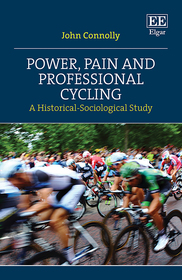
Power, Pain and Professional Cycling
A Historical-Sociological Study
- Publisher's listprice GBP 93.00
-
44 430 Ft (42 315 Ft + 5% VAT)
The price is estimated because at the time of ordering we do not know what conversion rates will apply to HUF / product currency when the book arrives. In case HUF is weaker, the price increases slightly, in case HUF is stronger, the price goes lower slightly.
- Discount 20% (cc. 8 886 Ft off)
- Discounted price 35 545 Ft (33 852 Ft + 5% VAT)
Subcribe now and take benefit of a favourable price.
Subscribe
44 430 Ft

Availability
Estimated delivery time: In stock at the publisher, but not at Prospero's office. Delivery time approx. 3-5 weeks.
Not in stock at Prospero.
Why don't you give exact delivery time?
Delivery time is estimated on our previous experiences. We give estimations only, because we order from outside Hungary, and the delivery time mainly depends on how quickly the publisher supplies the book. Faster or slower deliveries both happen, but we do our best to supply as quickly as possible.
Product details:
- Publisher Edward Elgar Publishing
- Date of Publication 11 June 2024
- ISBN 9781803927213
- Binding Hardback
- No. of pages212 pages
- Size 234x156 mm
- Weight 478 g
- Language English 569
Categories
Long description:
This insightful book presents a sociological study of professional cycling, examining developments in the sport since its emergence in the late 19th century. John Connolly thoroughly explores key aspects of professional cycling including the emergence of professionalism, organisational structure, doping, gender, and recent American involvement in the sport.
Power, Pain and Professional Cycling deftly outlines how and why Belgium, France and Italy initially dominated professional cycling and how the sport was shaped by power relations between those involved in the sport and in society at large. Tracing the interrelations between Americans and Europeans in the sport since the 1960s, Connolly documents the processes of stigmatisation and counter stigmatisation which occurred. He examines the ways in which changing power balances have reshaped both men’s and women’s professional racing today. The book also provides an insightful investigation into how feelings of shame associated with doping practices have developed and advanced; why this development was a fractured and uneven process; and why anti-doping functions emerged.
This book is a crucial read for academics and students specialising in sport, sport management, sport psychology and sport sociology. Its unique approach will also be of interest to professionals in the sports industry, particularly those with a keen interest in professional cycling.
This insightful book presents a sociological study of professional cycling, examining developments in the sport since its emergence in the late 19th century. John Connolly thoroughly explores key aspects of professional cycling including the emergence of professionalism, organisational structure, doping, gender, and recent American involvement in the sport.
‘Good historical research is being done sociologically and good sociology is being done historically. This is the book’s achievement: highlighting the forces within professional cycling over the course of a century to come to the present and present how things came to be the way they are today. The book is aimed at everyone with a sociological interest in professional cycling in Europe, at undergraduate and postgraduate level.’
Table of Contents:
Contents:
Preface and acknowledgements
1 Prologue: professional cycling, power relations and
thresholds of shame
2 The sociogenesis of professional cycling in France
3 Belgium, Italy and professionalism
4 Shifting power balances: cyclists, race organisers, team
owners and regulating bodies
5 Social constraints and self-restraints in the habitus
formation of professional cyclists
6 From stimulants to ‘doping’: stigmatisation processes and
advances in the threshold of shame
7 Declining power differentials and expanding social
constraints: the development of anti-doping functions in cycling
8 Professional cyclists and processes of identification and
dis-identification
9 Women in professional cycling: diminishing ‘outsider’
status and shifting sources of shame
10 Americans in Europe: the established as outsider
11 Afterword
Appendix: list of autobiographies
Bibliography
Index




